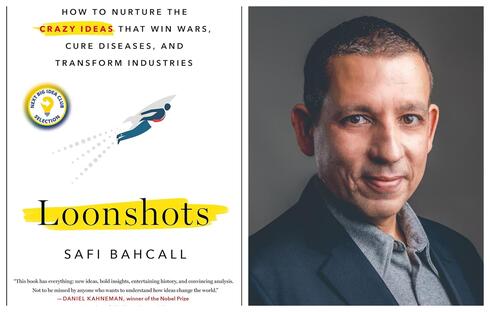
BiblioTech
CTech’s Book Review: Understanding ‘loonshots’ and embracing wild ideas
Roee Shibolet, Head of Israel R&D Center at Intuitive Surgical, has joined CTech to share a review of “Loonshots: How to Nurture the Crazy Ideas That Win Wars, Cure Diseases, and Transform Industries” by Safi Bahcall.
Roee Shibolet is the Head of Israel R&D Center at Intuitive Surgical, a biotechnology company that develops, manufactures, and markets robotic products designed to improve clinical outcomes of patients through minimally invasive surgery. He has joined CTech to share a review of “Loonshots: How to Nurture the Crazy Ideas That Win Wars, Cure Diseases, and Transform Industries” by Safi Bahcall.
Title: “Loonshots: How to Nurture the Crazy Ideas That Win Wars, Cure Diseases, and Transform Industries”
Author: Safi Bahcall
Format: Book
Where: Home, Commute
Summary:
"Loonshots" explores the science of nurturing radical breakthroughs in organizations. It’s about the ideas that are so original and ambitious that they are initially dismissed as crazy. The word itself is a combination of “loony” and “moonshot”, terms that capture the ambition of these ideas as well as the reaction they typically receive initially. Bahcall argues that even the most world-changing innovations such as the radar and insulin started as flawed and fragile ideas. They were repeatedly dismissed or ignored, and only due to luck or persistence did they eventually make it.
Bahcall’s idea is that it is possible to systematically plan to nurture loonshots. But to do so, you must adopt a specific approach to the structure of your organization. Bahcall presents four rules for establishing this structure. He argues that his rules can help organizations stay innovative, especially as they evolve from small startups to established organizations.
Bahcall, a physicist, CEO, and biotech entrepreneur, introduces theories that derive from his academic background as well as his management and consultant days. Loonshots is positioned as a management book, but it is also filled with detailed historical anecdotes that make it an interesting read for anyone interested in the history of scientific and technological innovation.
Important themes:
Anatomy of Loonshots
Bahcall describes two types of loonshots, the product or P-type and the strategic or S-type.
Product loonshots are new inventions or technologies, such as the first modern automobile invented by Karl Benz.
Strategy loonshots are new ways of doing business or tackling a problem. Ford’s assembly line production of the Model-T is a strategic innovation. Henry Ford did not invent motors or assembly lines, but the combination of the two to mass-produce cars made them affordable to the public and changed the automobile industry.
Bachall stresses the importance of paying attention to both types of loonshots, if you only focus on one type, you may develop a blind spot and let your competitors have the edge.
Loonshots require persistence and patience
Because they are fragile, especially in the early stages, it is important to not give up on them. Loonshots often start with flaws, and early failure is to be expected, but not all “deaths” as Bahcall terms them are true deaths, they may be just iterations of the idea as it gets perfected.
Loonshots evolve into Franchises
An important concept in the book is the distinction between loonshots and franchises. While loonshots are innovative ideas, franchises are the steady and reliable improvements of established ideas. The goal of every loonshot is to evolve into a franchise. Bahcall claims that loonshots and franchises can co-exist within the same organization.
Rules for nurturing and sustaining innovation
Bahcall outlines four rules which he names the Bush-Vail rules (after Vannevar Bush, head of the US office of Scientific R&D during WWII, and Theodore Vail, president of AT&T), that organizations should follow to stay innovative at any size.
To protect loonshots in their early stage, the first rule is the separation between the people who develop ideas from the people responsible for putting them into practice. This separation between innovators and implementors ensures that each group can have its unique set of tools, techniques, and dynamics that may not fit the other one.
The second rule is to encourage and create good and constant communication between the two teams. For an innovation to be worthwhile it needs to have a practical application. If the innovators are completely detached from the implementors there is a risk that they may lose touch with the practical implications of their work.
Since loonshots are fragile and are expected to fail often, the third rule states that you should focus on the process not the outcome. Specifically, it is important to analyze both failures and successes to determine what worked and what was the decision process. This way your decisions keep improving as you move to the next iteration.
Bahcall’s fourth rule is about sustaining innovation as a company grows. Once loonshots are successful they tend to evolve into franchises and iterations of incremental improvement. To sustain innovation, the book proposes to balance two factors, stake and rank. Balancing the need for promotion and rank within the organization with the stake of what the innovation can bring. A few management strategies are proposed to this end, including management structure, incentive planning, and minimizing politics.
Traps to be aware of when innovating
Towards the end, the book describes several traps that innovators might fall into while nurturing loonshots. The blind spot is a situation where a company is focused only on the newest product technologies and may become blind to strategic innovations that smaller competitors could use to outdo them. The Moses trap is when a company leader who is a strong visionary, pushes the company to invest in more and more innovations without considering their possible implementations and eventually going too far. Bahcall compares this type of leader to the biblical figure of Moses.
What I’ve learned:
Reading "Loonshots" has influenced my approach to innovation management. I've learned that fostering breakthrough ideas isn't just about hiring creative people or cultivating a certain culture – it's about carefully designing organizational structures that allow wild ideas to flourish without compromising operational excellence.
The concept of "phase transitions" has been particularly eye-opening. It's made me more attentive to subtle changes in our company structure that might inadvertently stifle innovation. I've also gained a new appreciation for the delicate balance between investing in new ideas and business opportunities and the sustainment of our core products in the market.
A concept that I adopted from the book, which I think is often overlooked, is the adaptation of the span of control (number of direct reports per manager) according to the function of the team. In teams focused on innovation, a larger span of control works better, as fewer managers create less controlled work processes and more independence that is needed to achieve loonshots. While in the franchise, more managers create a controlled and more stable work process that supports field execution and incremental improvement.
Perhaps most importantly, I've learned to be more patient with seemingly crazy ideas. Bahcall's insights on "false fails" have taught me to give promising concepts multiple chances and to look beyond initial setbacks. Sounds easy, but try doing that with budget constraints, time pressures and business goals to be met.
The concepts in the book are most comfortably applied to large groups and companies, but I have found that these same concepts can be applied in small teams and groups just as effectively, only in a microenvironment, it can be adopted at almost every level.
Critiques:
Most of the examples used in the book are historical and date as far back as the early 20th century. Some readers might find the extensive use of historical case studies less relevant to modern business challenges. In addition, while the book provides strategies, it could offer more practical guidance on implementing these ideas in diverse organizational contexts. There is also very little regard for external factors, the focus on internal structures sometimes overlooks the impact of market forces and external innovation ecosystems.
Who should read this book:
This book is a great read foremost for executives and senior managers in large companies. It could be very helpful to business strategists and consultants focusing on organization design. I believe it could also be beneficial for managers in startups that are mature, growing, and building the skeleton of a large company. In general, I would recommend it to any leader interested in fostering true innovation.















